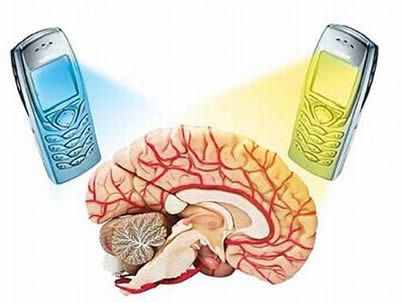Canadians are encouraged to limit cellphone call length and to text message or use a hands-free device whenever possible (to increase the distance between the cellphone and the user's head). Those under 18 should be especially careful to limit all cellphone use. Children are still growing and are therefore much more sensitive to external agents such as radiation.
In May, mobile phone owners were urged to limit their use after the World Health Organisation admitted they may cause cancer. The UN's health agency were the first international governing agency to advise 'pragmatic' measures to reduce exposure, such as using hands-free kits and texting instead of calling.
Despite decades of evidence, the disturbing report from the WHO marked the first time a link was admitted between mobiles and cancer, and follows earlier research linking just half an hour's use a day with up to 40 per cent higher odds of brain cancer.
The data obtained was enough for the International Agency for Research on Cancer to label cellphones as "possibly carcinogenic to humans." Most experts well-versed in the area of electromagenetic frequencies (EMF) and wireless technologies have little doubt that these devices are "most likely" capable of causing not only cancer, but a wide array of diseases in all living things.
Dr Christopher Wild, director of the WHO's International Agency for Research on Cancer, said: 'Given the potential consequences for public health, it is important that additional research be conducted into the long-term, heavy use of mobile phones.
"It seems that most of the world is addicted to cell phones and texting," stated technology specialist Chris Thompson. "You know we're addicted when people are driving and texting at the same time, or at the gym and texting in between sets...no that's addiciton," he added.
In a recent study, Swedish researchers published an epidemiologic report suggesting an increased risk of brain cancers (gliomas) as well as acoustic nerve tumors (neuromas) in people using cell phones for ten years or longer. Tumors were more likely to develop on the same side as the cell phone was used. Other studies by the same group suggested that the use of wireless handsets in cordless home phones posed the same risk.
After reviewing the evidence, one author even suggested that long-term cell phone use is "more dangerous to health than smoking cigarettes." Other recent commentators have raised similar concerns.
The findings are alarming in light of the exponential growth of cell phones-now including widespread use by children and teenagers. The damaging effects of EMF might be even greater in the developing brain.
The link is real since rates of brain cancers have increased over the last two decades. Some studies have reported that this is particularly the case for the most malignant brain cancers.
Changes Worldwide
Russian officials have recommended that children under the age of 18 years not use cell phones at all. Similarly, Israel, Belgium, Germany and India have discouraged use of cell phones by children. In Finland, the Radiation and Nuclear Power Authority has urged parents to err on the side of caution.
France has set the following recommendations:
Researchers from the National Institutes of Health have established that less than an hour of cellphone use can speed up brain activity in the area closest to the phone antenna. The study, published in The Journal of the American Medical Association, is among the first and largest to document that the weak radio-frequency signals from cellphones have the potential to alter brain activity.
- All cell phones must be sold with a device limiting head exposure to EMF.
- Any advertising campaign promoting the use of cell phones by children below 14 years is banned.
- Providing radio equipments designed for children under 6 may be banned by ministerial order.
- In kindergarten primary school and junior high, the use of cell phones is banned for kids during all teaching activities in locations listed in School rules.
- For all cell phones sold on the French territory the SAR must be indicated clearly and in French. Possible risks resulting from excessive use must also be mentioned.
Despite peer-reviewed scientific evidence which has overwhelmingly indicated that wireless devices, within the limits established by the F.C.C., do not pose a public health risk, evidence to the contrary has now outweighed these studies. Every year, hundreds of reputable experts and scientists are accumulating evidence which concur with an exponentially growing body of research which clearly validates the fact that wireless devices are indeed a public health risk and one not to be taken lightly.
Marco Torres is a research specialist, writer and consumer advocate for healthy lifestyles. He holds degrees in Public Health and Environmental Science and is a professional speaker on topics such as disease prevention, environmental toxins and health policy.
Sources:
IARC Classifies Radiofrequency Electromagnetic Fields as Possibly Carcinogenic to Humans
Do Cell Phones Increase Brain Cancer Risk?
Health Canada sets cellphone use restrictions
France - Legislation in Progress to Further Protect Children from Cell Phone Radiation
Cellphone Use Tied to Changes in Brain Activity




Reader Comments
to our Newsletter